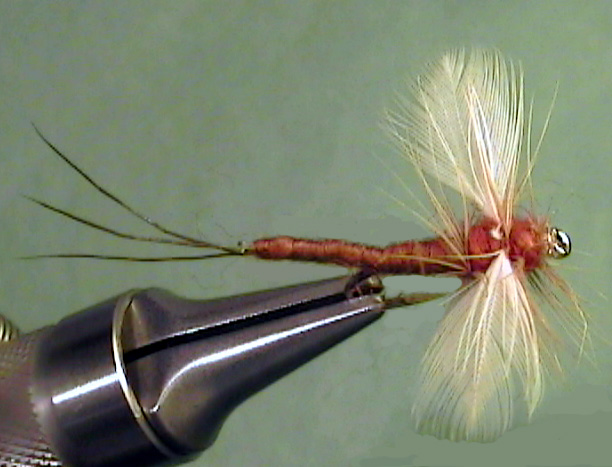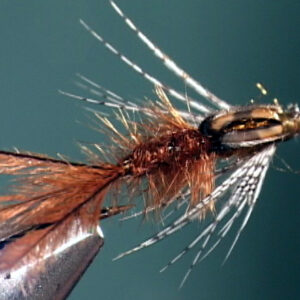Hook Size: 10/12
The Perfect Slate Drake Spinner is a imitation of the spinner stage of life of the mayfly. Once the dun reaches the banks, trees or bushes, it molts into a spinner, or the sexually mature adult. The males and females return to the water and mate in mid air, and eventually fall dead on the surface of the water where trout can easily dine on them. It should be fished on the surface and treated with floatant.
Slate Drake spinners are commonly called “White Gloved Howdys” because they look like
they are wearing white gloves on their front legs. The spinners usually come back to the
stream within two days of the time the hatch occurs. Mating takes place on-shore.
The female deposits her eggs by flying just over the surface. They will dip slightly into the
water to knock the eggs off. This activity usually occurs very late in the day or after dark
in some cases. Unless there’s a huge hatch, there’s usually not a large numbers of
spinners on the water at any one time.
These mayflies hatch over a very long period of time starting in the Spring and lasting
through the Summer into Fall. There’s usually a lag the hatches during the middle of the
Summer. For this reason, some anglers think they are bi-brooded or hatch twice a year
but this isn’t true. It’s just a long hatch period with a break in the middle of the period.
Presentation:
If you see females laying eggs on the surface of the water, you have the ideal situation.
You want to place your Perfect Fly Spinner imitation in the same area and the same type
of other areas in the stream where you see them or not. Remember, the hatches last
over a long period of time and most days the hatches are not heavy. That means the
spinner falls won’t be heavy. It doesn’t take many of these large mayflies to get the trout’s
attention. They get used to seeing the spinner falls over the long hatch period.
The females deposit their eggs in the same type of water they emerged from. This is
usually calmer areas of water in fast moving, pocket water streams. Usually a down and
across presentation works best. You do want to keep a drag free drift when imitating the
spinners. The exact type of presentation greatly depends on the particular type of water
you are fishing. If it’s pockets, you will probably want to use an up or up and across
presentation. You can usually stay hidden from the trout in pocket water and it’s best to
fish to trout looking in the opposite direction or away from your position.
In some cases you may find a trout feeding on the spinners and be able to cast to that
individual fish. That’s not often the case and most of the time you will be fishing blind. If
you do, most often it’s feeding in shallow water. This usually requires a long, downstream
presentation to where the fly reaches the trout before the leader does.
Copyright 2013 James Marsh

